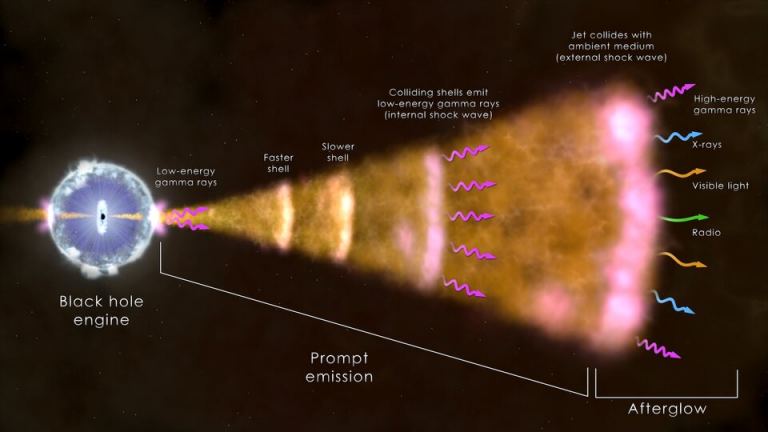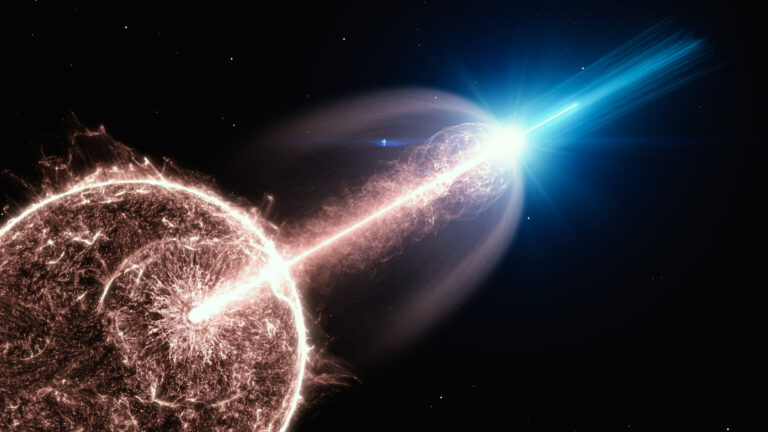A colossal bubble of gamma rays serves as a wellspring for highly energetic cosmic rays.
Gamma-ray bursts (GRBs) are among the most potent phenomena in the Universe that astronomers are diligently investigating to gain further insights into their origins. Recently, astronomers have achieved new milestones in observing the most powerful GRBs on record – such as GRB 190114C, which was observed by the Hubble Space Telescope in 2019, and GRB 221009A, detected by the Gemini South telescope in 2022. The same holds true for high-energy cosmic rays originating from within the Milky Way, the origins of which remain not entirely understood.
In a recent research endeavor, scientists from China’s Large High Altitude Air Shower Observatory (LHAASO) Collaboration uncovered a colossal gamma-ray burst (designated GRB 221009A) in the Cygnus star-forming region, surpassing 10 peta-electronvolts (PeV, 1PeV=1015eV), which is over ten times the average. Apart from being the most luminous GRB examined thus far, the team successfully determined the energy spectrum of the burst with precision, marking the first instance where astronomers have traced cosmic rays with such energy levels back to their origin.
The team, spearheaded by Prof. Cao Zhen from the Institute of High Energy Physics of the Chinese Academy of Sciences (CAS-IHEP), included CAS members Dr. Gao Chuandong, Dr. Li Cong, Prof. Liu Ruoyu, and Prof. Yang Ruizhi. Their findings were detailed in a paper titled “An ultrahigh-energy gamma-ray bubble powered by a super PeVatron,” published on November 15th in Science Bulletin. The LHAASO Collaboration is comprised of more than 280 members from 32 astrophysics research institutions worldwide.
The Large High-Altitude Air Shower Observatory (LHAASO) is a comprehensive array consisting of 5216 electromagnetic particle detectors, 1188 muon detectors, a 78,000-square-meter water Cherenkov detector array, and 18 wide-angle Cherenkov telescopes. Situated at an elevation of 4,410 meters (14468.5 ft) on Mount Haizi in Sichuan Province, China, this observatory is specifically dedicated to the study of cosmic rays. When cosmic rays penetrate Earth’s atmosphere, they generate “showers” of secondary particles, some of which reach the Earth’s surface.
The origin of cosmic rays is a highly significant topic in the field of astrophysics today. Over the past few decades, astronomers have detected three high-energy GRBs with a peak energy of approximately one petaelectronvolt (PeV), equivalent to one quadrillion electronvolts (1015eV), in their energy spectrum. Scientists believe that cosmic rays with energies below this threshold originate from astrophysical sources within our own Milky Way galaxy, such as supernovae. This peak energy level represents a boundary for cosmic rays, which typically manifest as protons accelerated to velocities close to the speed of light.
However, the origins of cosmic rays in the range of a few petaelectronvolts still remain an intriguing mystery in the field of astrophysics. Based on data collected by LHAASO, the Collaboration team made a remarkable discovery of a colossal ultra-high-energy gamma-ray bubble within the Cygnus X cluster, the largest star-forming region in our Solar neighborhood, located approximately 2.4 billion light-years away from Earth. Photons detected within this structure exhibited a maximum energy measurement of 2.5 PeV, while the emitted photons displayed energy values reaching up to 20 PeV, the highest ever recorded.
The team deduced the existence of a colossal cosmic ray accelerator in close proximity to the Bubble’s center. They attribute this to the presence of the massive star cluster Cygnus OB2 within Cygnus X. This cluster comprises numerous young massive stars, including blue-white O-type giants and B-type blue giants, with surface temperatures exceeding 35,000 and 15,000 °C (63,000 and 27,000 °F) respectively. These stars generate radiation pressure hundreds to millions of times greater than that of the Sun, resulting in the expulsion of stellar surface material and the formation of solar winds traveling at speeds of up to thousands of kilometers per second.

The interaction between the wind and the ISM results in the production of high-energy gamma rays and creates an optimal setting for effective particle acceleration. These discoveries mark the detection of the most energetic cosmic rays to date and the first-ever observation of a cosmic ray accelerator. The team’s findings also suggest that the accelerator significantly boosts the density of cosmic rays in the surrounding ISM, surpassing the typical levels found in the Milky Way. Furthermore, the measured intensity of background light in the infrared spectrum was notably lower than anticipated, approximately 40% of what current cosmological models predict.
These findings pose a challenge to the conventional model of GRB afterglows and may prompt astronomers to reconsider existing theories of galaxy formation and evolution. Additionally, they could offer valuable insights for testing Special Relativity (SR) and exploring the potential composition of Dark Matter as axions. Professor Elena Amato, an astrophysicist at the Italian National Institute for Astrophysics (INAF), emphasized that these results not only impact our comprehension of diffuse emission but also have significant implications for our understanding of cosmic ray (CR) transport within the Galaxy.
Do not forget to share your opinion with us to provide you with the best posts !




0 Comments